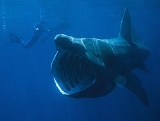
Basking shark
Overview
The basking shark is the second largest living fish
, after the whale shark
. It is a cosmopolitan
migratory
species
, found in all the world's temperate oceans. It is a slow moving and generally harmless filter feeder
and has anatomical adaptations to filter feeding, such as a greatly enlarged mouth and highly developed gill rakers. The shape of its snout is conical and the gill slits extend around the top and bottom of its head. The gill rakers are dark and bristle-like and are used to catch plankton as water filters through the mouth and over the gills.
Fish
Fish are a paraphyletic group of organisms that consist of all gill-bearing aquatic vertebrate animals that lack limbs with digits. Included in this definition are the living hagfish, lampreys, and cartilaginous and bony fish, as well as various extinct related groups...
, after the whale shark
Whale shark
The whale shark, Rhincodon typus, is a slow-moving filter feeding shark, the largest extant fish species. The largest confirmed individual had a length of and a weight of more than , but unconfirmed claims report considerably larger whale sharks...
. It is a cosmopolitan
Cosmopolitan distribution
In biogeography, a taxon is said to have a cosmopolitan distribution if its range extends across all or most of the world in appropriate habitats. For instance, the killer whale has a cosmopolitan distribution, extending over most of the world's oceans. Other examples include humans, the lichen...
migratory
Fish migration
Many types of fish migrate on a regular basis, on time scales ranging from daily to annually or longer, and over distances ranging from a few metres to thousands of kilometres...
species
Species
In biology, a species is one of the basic units of biological classification and a taxonomic rank. A species is often defined as a group of organisms capable of interbreeding and producing fertile offspring. While in many cases this definition is adequate, more precise or differing measures are...
, found in all the world's temperate oceans. It is a slow moving and generally harmless filter feeder
Filter feeder
Filter feeders are animals that feed by straining suspended matter and food particles from water, typically by passing the water over a specialized filtering structure. Some animals that use this method of feeding are clams, krill, sponges, baleen whales, and many fish and some sharks. Some birds,...
and has anatomical adaptations to filter feeding, such as a greatly enlarged mouth and highly developed gill rakers. The shape of its snout is conical and the gill slits extend around the top and bottom of its head. The gill rakers are dark and bristle-like and are used to catch plankton as water filters through the mouth and over the gills.

